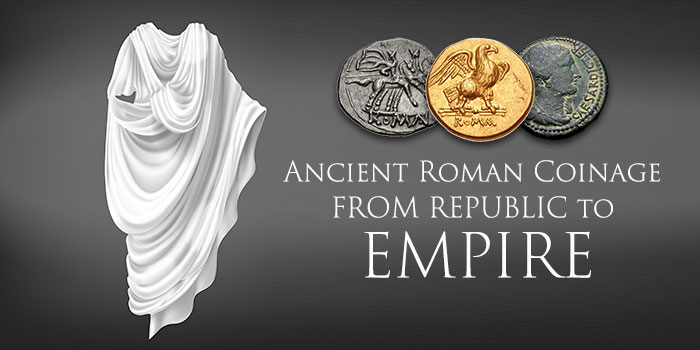
By Steve Benner for CoinWeek …..
The coinage of the ancient Romans underwent considerable changes as the government transitioned from a republic to an empire. Some coins like the denarius would continue through the imperatorial period into the Empire only slightly reduced in weight. Some would disappear, like the victoriatus. And some, like the sestertius, would change completely.
During the imperatorial period, the coinage became more political in that it would serve as propaganda for generals like Sulla and Pompey who were vying for control of Rome. The coinage would become more “user-friendly” with changes in the types and denominations under the first emperor, Augustus. This article will begin with the coin reforms of 211 BCE and continue well into the Empire of the first century CE.
Roman Republican Coinage
Starting about the end of the fifth century, the coinage consisted of large bronzes made in Rome with irregularly shaped pieces, called aes rude, transitioning to cast flat bars called aes signatum in the fourth century, and finally to cast coins, called aes grave, in the early third century. These large coins came in several denominations, including the as, the semis, the triens, etc., and were actually “full value currency”, meaning they were not token currency. The larger denominations could be over 60 mm in diameter and over 200 grams in weight.
Early in the third century, the Romans introduced a silver didrachm that was minted at Neapolis. This coin was in the Greek style of coins and helped facilitate trade with the Greeks and pay Rome’s soldiers. Around 269 BCE, the first coin minted in Rome was also a didrachm, with Heracles on the obverse and a she-wolf suckling the Roman twins on the reverse. This is a very rare coin. In 235 BCE, the last silver coin minted before the reforms was similar to a didrachm and was called the quadrigatus, named after the quadriga (a four-horse chariot) on the reverse.
The coin reforms of 211 BCE were far-reaching, with several new denominations replacing the old. Note that some historians think this reform may have started earlier, around 218. The most significant new coin was the denarius, a silver coin weighing 4.5 grams (72 to the Roman pound) that would continue to be minted into the late third century CE. The coin had an “X” on the obverse that signified it was worth 10 asses. The obverse features a personified Roma with X behind its head, and the reverse has the Dioscuri (the twin gods Castor and Pollux) riding right with Victory flying behind and ROMA below.
Very large quantities of denarii were minted from the silver capture during the sack of Syracuse in Sicily in 212 BCE.
Two fractions of the denarius were also introduced. The quinarius was a half denarius worth five (“V”) asses, and the sestertius was a quarter denarius worth 2.5 (“IIS”) asses. The style is the same as for the denarius except with “V” for the quinarius on the obverse and “IIS” (two asses and a semis) for the sestertius.
The weight of the denarius would shrink with time, going from 4.5 grams in 211 to 3.7 in the 170s BCE. Plus, around 140 BCE, the denarius was re-tariffed at 16 asses, and the obverse “X” became either an “XVI” or an “X” with a crossbar. The semis and sestertius were changed appropriately.
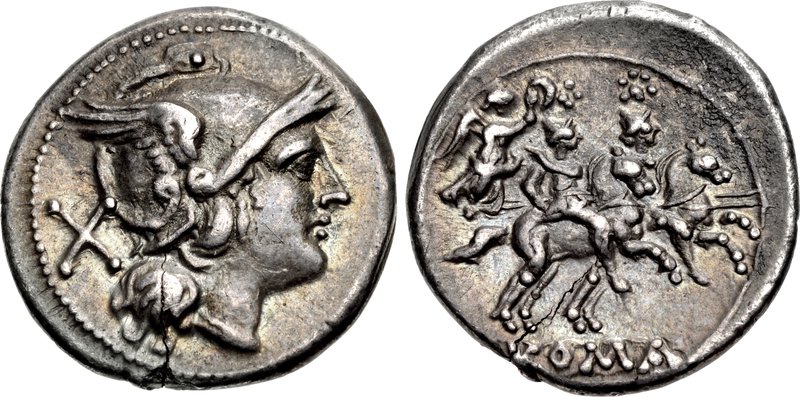
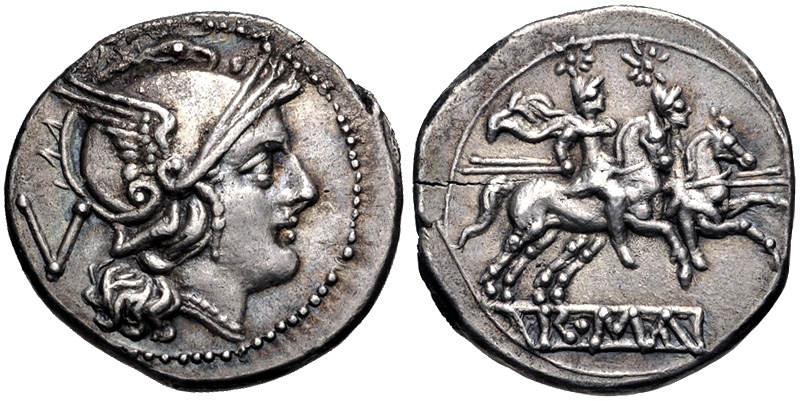
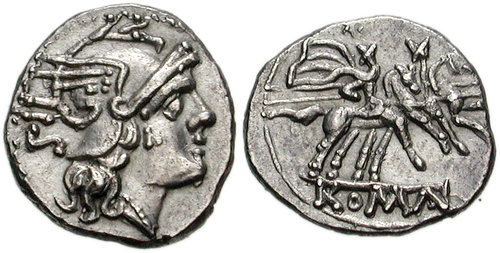
Another denomination that was created at this time was the silver victoriatus. Its weight was about three-quarters that of the denarius and was produced in large quantities. Rome was in need of coins to pay its expenses during the Second Punic War (218-201 BCE). Since most of the finds of this coin have been in southern Italy, Sicily, Cisalpine Gaul, and Spain, it may be that this coin was mainly for payment to Roman’s allies in these regions. The victoriatus was probably meant to relate to the drachm, a coin more well known in the Greek world. In terms of fineness, the denarius had a silver content of about 96%; that of the victoriatus could be as low as 72%. The coin gets its name from the reverse of Victory placing a wreath on a trophy. The obverse is the head of Jupiter to the right. The coin was popular and, even though it was discontinued about 170 BCE, it continued to circulate for years becoming so worn as to be considered a quinarius.

Also around 211 BCE, three new denominations of gold coins were minted: one each worth 60, 40, and 20 asses. All three coins have the head of Mars right obverse and eagle standing on thunderbolt with wings spread. To mark the difference, the 60 has an arrow pointing down with an “X”, the 40 has “XXXX”, and the 20 has “XX”. Again, the gold probably came from Syracuse, but it has been suggested that Ptolemy IV may have supplied the gold. The gold coins were issued twice: once right after the reform and again near the end of the war. Gold coins would not be issued again until the 80s BCE by Lucius Cornelius Sulla (138–78 BCE), when it would be called an aureus.

The last coins to deal with are the bronzes. The as was now struck and not cast. The weight was reduced to a sextantal standard (six to the pound), but the weight would continue to be reduced until all bronze coins were discontinued around 82 BCE. There were many denominations of bronzes, many of whose names would appear again in imperial times – including the dupondii asses, semis, and quadrans. Each denomination had a standard obverse and reverse. The asses had a Janus head and ship’s prow; the semis had Saturn and prow with an “S”; the triens had Minerva and a prow with four pellets, etc.

The Imperatorial Period
The next important period of coinage change was the Imperatorial Period. Usually, this period is said to begin around 49 BCE with the conflict between Pompey and Julius Caesar, but numismatically it is better to start this period around 82 BCE. The reasons are threefold: 1) bronze coins are discontinued, at least temporarily; 2) gold coins are being minted again; and 3) the name of a living person–in this case L.C. Sulla–began appearing on coins. In an effort to kill two birds with one stone (points 2 & 3), the coin below shows a gold aureus (the new name for gold coins) with Sulla’s name on the reverse. The obverse has the head of Roma right, and a reverse with Sulla driving a quadriga with Victory above: L. SVLLA IM is in the exergue.

The denarius was by far the most common Roman coin in circulation, though the quinarius and sestertius were still being minted (in much smaller quantities). The silver sestertius would be discontinued circa 44 BCE, but the quinarius would continue on into the Imperial period. Gold coins were minted only intermittently until the time of Julius Caesar (100-44 BCE) when large numbers of them were minted for his planned invasion of Parthia. The early aurei weighed about 10.5 grams, but Caesar standardized the weight at 1/40th of a pound (about 8 grams). It was valued at 25 denarii. Caesar also began minting the gold quinarius or half aureus.
By the latter half of the second century CE, it had become common for Roman moneyers to put their names on the silver coins they minted. In the first century, moneyers also began placing their ancestors’ names and portraits on the silver coins to celebrate them and their family (gens); however, portraits of living people were not depicted on coins. Julius Caesar broke this rule when he began placing his portrait on his silver coins. Once this genie was out of the bottle, many of the combatants in the series of wars following Caesar’s assassination in 44 BCE placed their own portraits on coins as well.
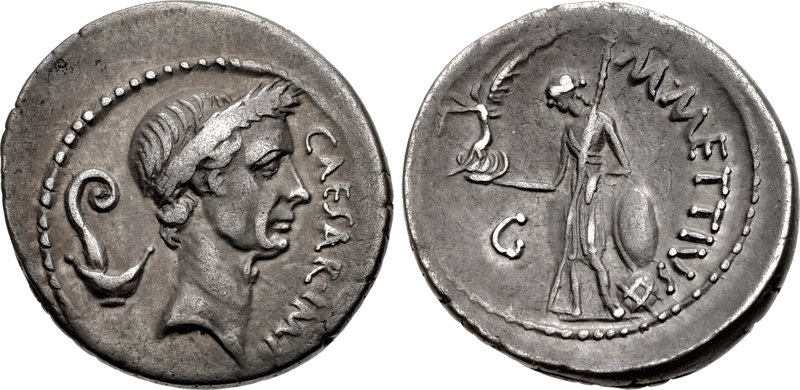
Bronze coins did make a slight comeback during this period. Julius Caesar minted a dupondius with the head of Victory right on the obverse, and Minerva advancing left on the reverse. The obverse legend refers to Caesar as dictator for the third time, and the reverse legend refers to the prefect Gaius Clovius. Pompey the Great’s sons, Gnaeus and Sextus, minted a few bronze asses, one of which had their father’s face on a Janus profile. Octavian (later Augustus) minted a few sestertii/dupondii with either his adopted father’s name or portrait on them. Mark Antony did actually mint a number of bronze coins, including a sestertius, tressis, dupondius, as, semis, and quadrans (referred to as his “fleet coinage”) in 38 BCE. This was probably the basis of Augustus’ imperial bronze coins.
Imperial Coinage
After his victory at Actium in 31 BCE, Octavian was the sole ruler of the Roman Empire. By 23 BCE, he had given up much of his more obvious power, such as the consulship, though keeping the real reins of power in his hands. With respect to the coinage, he kept the minting of the gold and silver coins under his control while allowing the Senate to mint the bronze and orichalcum (brass) ones, hence the “SC” (senatus consultum) on these coins (Figure 10). The precious metal coins, the gold aureus and quinarius, and the silver denarius and quinarius, passed into the Imperial coinage from republican/imperatorial times with little change. The most important change was that, henceforth, only the Emperor’s or his family members’ portrait would be displayed on the coinage (note: there were some exceptions for significant events).
After Octavian’s death, the silver quinarius was not minted again until the second half of the first century CE. Another silver coin that was widely circulated at this time was the cistophorus, which was minted in the Greek cities of Asia Minor and weighed about 12 grams. This coin was originally begun by Mark Antony late in the Imperatorial period but continued to be minted into the second century CE.
In circa 18 BCE, Augustus introduced the new orichalcum sestertius and dupondius and the bronze as, a concept introduced by Mark Antony. The dupondius did not have the portrait of the emperor on it until Tiberius’ (14-37 CE) reign and the sestertius didn’t until Caligula’s (37-41 CE) The bronze as already had the emperor’s portrait on the obverse. The mint at Lugdunum (modern Lyon, France)produced all three denominations (plus the semis and quadrans) with Augustus’ profile in its “altar” series. These early bronze/brass coins were called the “moneyers’ series” because the moneyer’s names were in the reverse legends; a practice that was discontinued by the time of Tiberius.
During and after Nero’s reign (54-68 CE), the emperor’s profile on the dupondius obverse would have a crown, making it easier to distinguish from the as. Two additional small bronze coins were also introduced about this time: the brass semis and the copper quadrans. Both coins were issued from the Lugdunum mint initially and were mainly used for ceremonial purposes. The semis would usually have the emperor’s profile, but the quadrans would not. The semis was only minted occasionally by Augustus’ successors, but the quadrans, with the exception of Tiberius, was minted extensively by the rest of the Julio-Claudian emperors.
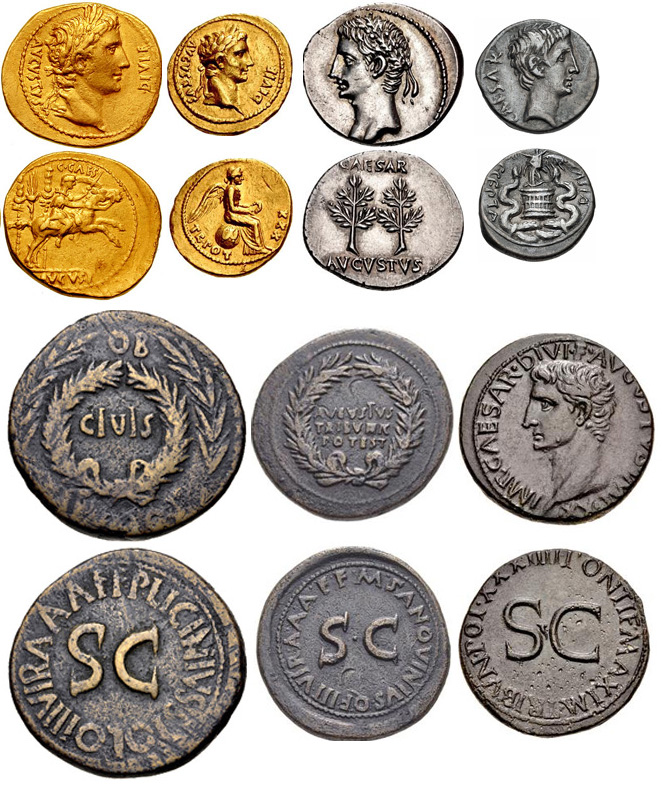
The values of these reformed coins were as follows: aureus – 25 denarii; gold quinarius – 12.5 denarii; denarius – 16 asses; silver quinarius – 8 asses; sestertius – 4 asses; dupondius – 2 asses; as – 4 quadrantes; semis – 2 quadrantes; and a quadrans. These coins would be the mainstay of Roman Imperial coinage for three hundred years. One change was in 215 CE when the antoninianus or double denarius was introduced by Caracalla, which slowly drove the denarius out of circulation. Another was the double sestertius introduced by Trajan Decius (249-251 CE), but after his death only the usurper Postumus issued double sestertii. This coinage system was eventually replaced by the coinage reforms of Diocletian in 294 CE.
* * *
References
Crawford, Michael H. Roman Republican Coinage. UK: Cambridge University Press (1974)
Hornblower, Simon; Spawforth, Antony (ed.). The Oxford Classical Dictionary. Oxford (1996)
Madden, F.; Smith, C.R.; Stevenson, S.W. A Dictionary of Roman coins. London (1889)
Sear, David. Roman Coins and Their Values I. Spink (2002)
Vagi, David. Coinage and History of the Roman Empire (2 volumes). Coin World (1999)
* * *





I have a Roman coin I would like to authenticate it and possibly sale it